 June 2019
The challenge of planetary protection
June 2019
The challenge of planetary protection
...the spacecraft. This is achieved by assembling the spacecraft in biologically controlled cleanrooms, using heat, plasma and ionising radiation to reduce the bilogical contamination, and barrier systems (e.g. purging, filters and seals) to control the...
 28 June 2016
Oxides discovered on Mars hint at an oxygen-rich past
28 June 2016
Oxides discovered on Mars hint at an oxygen-rich past
... that Mars’s atmosphere had an abundance of oxygen due to the planets weak magnetic field. Without a protective shield, ionising radiation would be able to penetrate the atmosphere and break water molecules down to its constituent parts; hydrogen and...
 24 May 2021
A CubeSat that produces visible light on the ground to be launched in NASA initiative
24 May 2021
A CubeSat that produces visible light on the ground to be launched in NASA initiative
... (Supernova Remnants and Proxies for ReIonization Testbed Experiment), a scientific investigation mission designed to observe ionising radiation escape from low redshift star-forming galaxies, and AEPEX (Atmospheric Effects of Precipitation through...
 01 November 2021
Curiosity finds organic molecules in Mars sand dune
01 November 2021
Curiosity finds organic molecules in Mars sand dune
... (22 mile) long by 1-2 km wide dune field that wraps around the northwest side of Mount Sharp. Likely exposed to ionising radiation for millions of years, these large, active Martian sand deposits are not expected to be rich in well preserved...